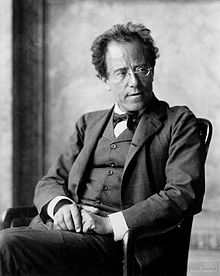July 2, 2018. Cluck and Mahler. Christoph Gluck was born on this day in 2014. We wrote about him a year ago, so for now here ’s the chorus Chaste fille de Latone’ from Act 4 of Gluck’s opera Iphigénie en Tauride. Many noted the similarity between this chorus and March of the Priests from Mozart’s Die Zauberflöte (here). This of course is not to compare the genius of the younger composer and the considerable but still limited talents of Christoph Willibald Gluck.
 Gustav Mahler was born on July 7th of 1860. For some time we’ve been tracing his life by his major works; last year we wrote about 1901-1902, the years surrounding the creation of the Fifth Symphony. In 1903 he started working on Symphony no. 6. This was one of the happiest periods in Mahler’s life. He was newly wed to the dashing Alma, their first daughter, Maria, was born on November of 1902 (their second daughter, Anna, would be born in June of 1904). Mahler was financially secure and firmly established in Vienna’s cultural scene. Hofoper, of which he was the music director, was the most prestigious music institution of the Empire, but Mahler was also working with younger, more adventuresome musicians: he was elected the honorary president of the Association of Creative Musicians in Vienna, founded by Arnold Schoenberg and Alexander von Zemlinsky (Berg and Webern were also members of the group). At the Opera, he passed some of the day-to-day activities to his staff conductors, Franz Schalk and Bruno Walter. Mahler invited Alfred Roller, a Secessionist painter, to Hofoper as the set designer. Their 1903 production of Tristan und Isolde was a big success. During that period Mahler started traveling more often. In Amsterdam, he established a close relationship with Willem Mengelberg, the conductor of Concertgebouw Orchestra. Mengelberg, together with Bruno Walter, would become major Mahlerian of the next generation.
Gustav Mahler was born on July 7th of 1860. For some time we’ve been tracing his life by his major works; last year we wrote about 1901-1902, the years surrounding the creation of the Fifth Symphony. In 1903 he started working on Symphony no. 6. This was one of the happiest periods in Mahler’s life. He was newly wed to the dashing Alma, their first daughter, Maria, was born on November of 1902 (their second daughter, Anna, would be born in June of 1904). Mahler was financially secure and firmly established in Vienna’s cultural scene. Hofoper, of which he was the music director, was the most prestigious music institution of the Empire, but Mahler was also working with younger, more adventuresome musicians: he was elected the honorary president of the Association of Creative Musicians in Vienna, founded by Arnold Schoenberg and Alexander von Zemlinsky (Berg and Webern were also members of the group). At the Opera, he passed some of the day-to-day activities to his staff conductors, Franz Schalk and Bruno Walter. Mahler invited Alfred Roller, a Secessionist painter, to Hofoper as the set designer. Their 1903 production of Tristan und Isolde was a big success. During that period Mahler started traveling more often. In Amsterdam, he established a close relationship with Willem Mengelberg, the conductor of Concertgebouw Orchestra. Mengelberg, together with Bruno Walter, would become major Mahlerian of the next generation.
Like the Fifth, the Sixth symphony was composed at Maiernigg, a small village near the resort town of Maria Wörth in Carinthia, in his “composing hut.” Mahler conducted the premier in 1906. The symphony is often subtitled “Tragic”; even though it’s not on the original score, one of the Vienna concerts which Mahler conducted had this sobriquet printed on the program, so clearly, he agreed with it. This is rather paradoxical, considering that it was written when everything seemed to be going well in Mahler’s life, and many real tragedies that befell him were still to come. The symphony consists of four movement: 1. Allegro energico, ma non troppo. Heftig, aber markig (Violent but succinct); 2. Scherzo: Wuchtig (powerful); 3. Andante moderato; and 4. Finale: Sostenuto – Allegro moderato – Allegro energico. That was the sequence of the movement when the score was initially published. Then, while rehearsing, Mahler decided to move around two inner sections, playing the slow Andante moderato first, followed by the Scherzo. Apparently, that’s how he performed it on the premier and that’s how it was performed for a while. Then, in 1919, Alma Mahler sent a telegram to Willem Mengelberg, with "First Scherzo then Andante" in it. Even though Mengelberg had performed the symphony following Mahler’s later order, with the Andante preceding the Scherzo, he obeyed Alma’s direction. This is the order in which most conductors perform the Symphony these days, and this’s how Leonard Bernstein plays it with the Vienna Philharmonic orchestra in the 1989 recording. Here are: Allegro, Scherzo, Andante, Finale.
| Source: | https://www.classicalconnect.com/node/12616 |
| Website: | Classical Connect |